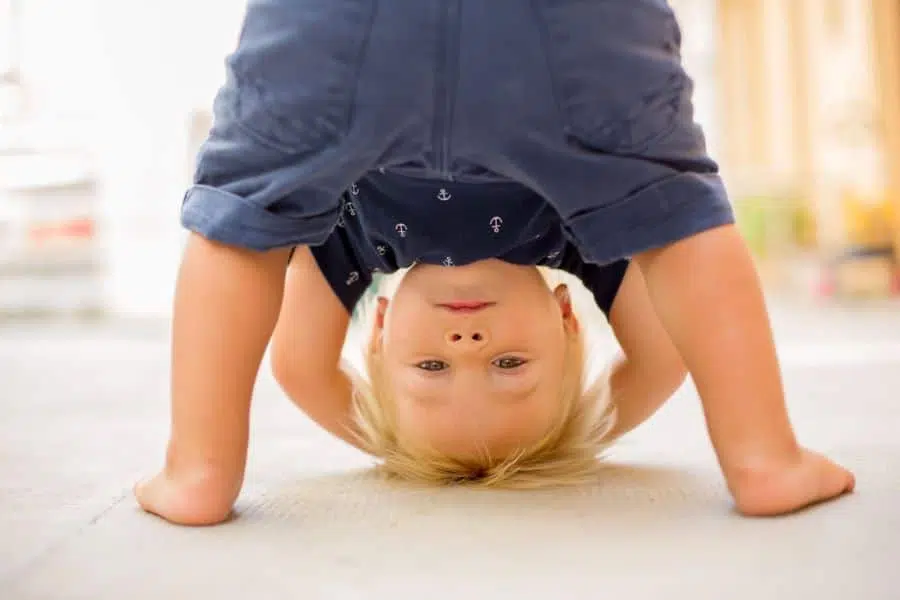When one of my daughters was small, she used to climb everything! She would climb on toys to get up the back of the sofa and then roll down onto the cushions.
At the beach, she’d find cliffs or big rocks and try to scale them. In the supermarket she once climbed a gigantic pile of toilet rolls, sending them all spinning down the aisles.
I wished I’d known at the time, that this little daredevil daughter was actually going through something called an orientation schema.
It’s very common and a normal part of child development for all toddlers.
So why is my child watching TV upside down? you might ask.
Children with an orientation schema are interested in viewing the world in unusual ways and from different perspectives. Children who show this kind of behavior enjoy being upside down and looking at everything from an unusual viewpoint.
In this post, I’ll describe exactly why this happens, and most importantly – what to do about it.

Orientation Schemas – An Overview
Have you ever noticed how toddlers sometimes like to view the world from very strange angles?
You may have noticed how they love to be held aloft, high in the air, or they enjoy being swung between two grown-ups. You may have noticed your toddler getting themselves into a yoga pose, looking at the world through their legs, or hanging upside down off the sofa to watch the TV.
You might have wondered what on earth they’re doing. Surely they can’t be making sense of the world from that angle!
In fact, that is exactly what they are doing – they’re making sense of their world and generally, it is nothing to worry about.
At some point in our lives, we’ve all done the same. Toddlers need to experiment with different angles to discover what the world looks like from different points of view.
Sometimes, this is referred to as the orientation schema. That’s really just a fancy way of saying that your child is discovering how to see things from a different point of view, a different perspective, or a different angle.
Toddlers are actually developing an important life skill when they put themselves in these funny positions, and so it’s important to give your child the freedom to explore and experiment. They will be building confidence and skills in their own physical abilities and as they get older, this will help them in lots of different ways.
They Are Learning A Range Of Skills
Children with a good sense of perspective tend to have stronger physical skills later on in life. (Yes, really!) Skills like:
- Anticipating other sports players’ moves in a game
- Dodging and tackling
- Spatial awareness
- Tracking a ball with their eyes.
- Moving with skill and coordination.
- Climbing and balancing
Just think of the skills a gymnast, footballer, or climber needs. A good awareness of angles and perspective is a huge advantage.
How To Support This Kind Of Behavior
Though it might seem strange, supporting and even encouraging this kind of play will have many benefits. (Source)
If you notice your toddler is experimenting and exploring their world from various different angles, there are lots of ways to support them:
- Hold their hand as they balance along a bench or a low wall
- Allow them the freedom to climb up and down steps (safely)
- Roll down a mound of earth or a small hill
- Practice baby/toddler yoga
- Crawl through a tunnel
- Encourage them to access rope and tire swings

Make sure that they have plenty of space to roll about and lie flat.
Give them the freedom to hang upside down if they want to, as long as they are doing it in a safe way.
You can also support them by holding them up in the air or allowing them to climb on you when you are playing together on the floor.
You can turn them upside down (maybe not straight after a meal) and sit them on your shoulders. These will all support your child as they move through this phase.
Climbing frames are a great resource for a child exploring the orientation schema and real trees or bushes that can be climbed are even better!

How Long Does This Phase Last?
Children may need to repeat these actions over and over again until their brain has processed what the world looks like from different angles.
There is no definite timescale to how long this schema may last – but the more it is supported the quicker they will process the information, and the more they will learn.
Most adults don’t do this anymore because we already have an idea of what the world would look like if we stood on our heads, but your toddler is still trying to figure it out. They are learning every minute of every day and are trying to make sense of their world so we shouldn’t assume they already know this.
What To Do When Your Child Goes Upside Down
The next time your toddler hangs upside down, looks through their legs at you, puts themselves in a strange position, or rolls around on the floor, don’t be tempted to stop them. Give them their freedom and let them explore.
Children will naturally find ways of climbing, rolling, and changing positions, so you don’t need to provide lots of expensive resources.
Most children will pass through this phase eventually, but there are adults out there who are still in an orientation schema.
If you know someone who enjoys rock climbing, trampolining, riding a roller coaster, or a zip wire, they may still be experimenting with the Orientation phase.
My little climber? She’s now a grown-up and recently did a parachute jump so I guess she still enjoys viewing the world from strange and wonderful viewpoints – Nothing wrong with that at all!
